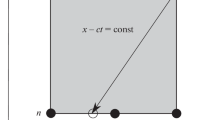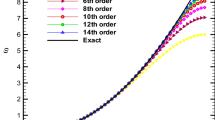Abstract
The dissipation and dispersion properties of the Hermite characteristic scheme intended for solving the one-dimensional advection equation are examined. The scheme is based on Hermite interpolation using not only the nodal values of the function, but also the nodal values of its spatial derivative. The derivatives at a new time step are computed so as to ensure the correct redistribution of the input fluxes over the output faces. Note that the scheme is constructed within a single cell, so it belongs to the class of bicompact schemes. The derivatives at a new time level are reconstructed using an integral average and the Euler–Maclaurin formula. The scheme is compared with modern conservative schemes, such as the bicompact Rogov scheme and the Goloviznin–Chetverushkin scheme. It is shown that the Hermite characteristic scheme has low dissipation and ultralow dispersion as compared with schemes of the same class. The dispersion of the Hermite characteristic scheme is lower than that of the semidiscrete bicompact Rogov scheme. In turn, the latter scheme with time approximation based on the trapezoidal rule has zero dissipation. Similar ideas of using characteristic schemes with an additional algorithm ensuring conservativeness are used in the Goloviznin–Chetverushkin scheme, which is the simplest in implementation. The schemes used for comparison have a compact stencil and similar technics used for closing difference schemes.








Similar content being viewed by others
REFERENCES
B. V. Rogov and M. N. Mikhailovskaya, “Fourth-order accurate bicompact schemes for hyperbolic equations,” Dokl. Math. 81, 146–150 (2010).
B. V. Rogov and M. N. Mikhailovskaya, “Monotonic bicompact schemes for linear transport equations,” Math. Models Comput. Simul. 4 (1), 92–100 (2012).
M. N. Mikhailovskaya and B. V. Rogov, “Monotone compact running schemes for systems of hyperbolic equations,” Comput. Math. Math. Phys. 52 (4), 578–600 (2012).
E. N. Aristova and B. V. Rogov, “Implementation of boundary conditions in bicompact schemes for the linear transport equation,” Mat. Model. 24 (10), 3–14 (2012).
E. N. Aristova and B. V. Rogov, “Bicompact scheme for the multidimensional stationary linear transport equation,” Appl. Numer. Math. 93, 3–14 (2015).
E. N. Aristova, B. V. Rogov, and A. V. Chikitkin, “Optimal monotonization of a high-order accurate bicompact scheme for the nonstationary multidimensional transport equation,” Comput. Math. Math. Phys. 56 (6), 562–576 (2016).
A. V. Chikitkin and B. V. Rogov, “Family of central bicompact schemes with spectral resolution property for hyperbolic equations,” Appl. Numer. Math. 142, 151–170 (2019).
B. V. Rogov, “Dispersive and dissipative properties of the fully discrete bicompact schemes of the fourth order of spatial approximation for hyperbolic equations,” Appl. Numer. Math. 139, 136–155 (2019).
B. V. Rogov and A. V. Chikitkin, “About the convergence and accuracy of the method of iterative approximate factorization of operators of multidimensional high-accuracy bicompact schemes,” Mat. Model. 31 (12), 119–144 (2019).
I. L. Tsvetkova and A. V. Shilkov, “Averaging of transport equation in a resonantly absorbing medium,” Mat. Model. 1 (1), 91–100 (1989).
A. V. Shilkov, “Methods for averaging cross sections and spectrum in neutron transport,” Mat. Model. 3 (2), 63–81 (1991).
A. V. Shilkov, “Generalized multigroup approximation and Lebesgue averaging method in particle transport problems,” Transp. Theory Stat. Phys. 23 (6), 781–814 (1994).
A. V. Shilkov and M. N. Gerthev, “Verification of the Lebesgue averaging method,” Math. Models Comput. Simul. 8 (2), 93–107 (2016).
E. N. Aristova, M. N. Gertsev, and A. V. Shilkov, “Lebesgue averaging method in serial computations of atmospheric radiation,” Comput. Math. Math. Phys. 57 (6), 1022–1035 (2017).
A. V. Shilkov, “Lebesgue moment method for solving the neutron transport equation,” Mat. Model. 32 (5), 59–94 (2020).
E. N. Aristova and G. I. Ovcharov, “Hermitian characteristic scheme for a linear inhomogeneous transfer equation,” Math. Models Comput. Simul. 12 (6), 845–855 (2020).
V. M. Goloviznin and B. N. Chetverushkin, “New generation algorithms for computational fluid dynamics,” Comput. Math. Math. Phys. 58 (8), 1217–1225 (2018).
T. Yabe, T. Aoki, G. Sakaguchi, et al., “The compact CIP (cubic-interpolated pseudo-particle) method as a general hyperbolic solver,” Comput. Fluids 19 (3/4), 421–431 (1991).
T.-L. Tsai, S.-W. Chiang, and J.-G. Yang, “Characteristics method with cubic-spline interpolation for open channel flow computation,” Int. J. Numer. Methods Fluids 46, 663–683 (2004).
T. Yabe, F. Xiao, and T. Utsumi, “The constrained interpolation profile method for multiphase analysis,” J. Comput. 169 (2), 556–593 (2001).
T. Aoki, “Stability and accuracy of the cubic interpolated propagation scheme,” Comput. Phys. Commun. 101 (1–2), 9–20 (1997).
V. I. Golubev, I. B. Petrov, and N. I. Khokhlov, “Compact grid-characteristic schemes of higher orders of accuracy for a 3D linear transport equation,” Math. Models Comput. Simul. 8, 577–584 (2016).
A. V. Favorskaya and I. B. Petrov, “Numerical modeling of wave processes in rocks by the grid-characteristic method,” Math. Models Comput. Simul. 10 (5), 639–647 (2018).
I. B. Petrov, A. V. Favorskaya, and N. I. Khokhlov, “Grid-characteristic method on embedded hierarchical grids and its application in the study of seismic waves,” Comput. Math. Math. Phys. 57 (11), 1771–1777 (2017).
Author information
Authors and Affiliations
Corresponding authors
Additional information
Translated by I. Ruzanova
Rights and permissions
About this article
Cite this article
Aristova, E.N., Astafurov, G.O. Comparison of Dissipation and Dispersion Properties of Compact Difference Schemes for the Numerical Solution of the Advection Equation. Comput. Math. and Math. Phys. 61, 1711–1722 (2021). https://doi.org/10.1134/S0965542521110026
Received:
Revised:
Accepted:
Published:
Issue Date:
DOI: https://doi.org/10.1134/S0965542521110026




